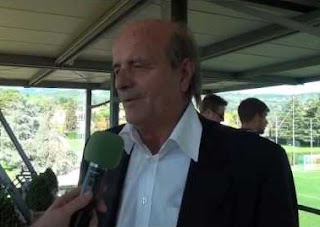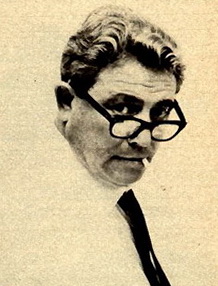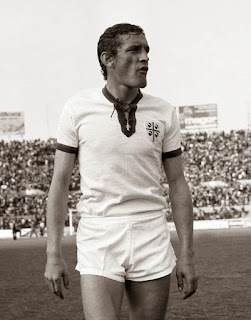‘King of own goals’ was also a champion
 |
| Comunardo Nicolai was a member of the most successful team in Cagliari's history |
Niccolai scored six own goals in his Serie A career, which contributed to his standing as something of a cult figure in Italian football.
He was actually an exceptionally talented player - good enough to be picked for the Italian squad for the World Cup in 1970, where the azzurri finished runners-up, as well as a key figure in the Cagliari team that won the Serie A title in 1970.
But he seemed unable to avoid moments of freakish bad luck and he acquired such unwanted notoriety as a result that people outside the game still reference his name when describing someone doing something to their own disadvantage.
For example, during the course of one of the regular political crises in Italy in the late 1990s, the right-wing politician Francesco Storace said of a policy decision taken by prime minister Massimo D’Alema, “Ha fatto un autogol alla Niccolai” - meaning that he had “scored an own goal Niccolai-style”.
 |
| Niccolai's most famous own goal - against Juventus during the 1969-70 title-winning season |
Comunardo played his first football with the youth team at Montecatini before he was transferred to Torres, a club from Sassari in Sardinia. From there he signed for Cagliari in 1964, joining a team that had just been promoted to Serie A.
Cagliari, who have never before or since been such a force in Italian football, steadily built a squad that was capable of challenging for the Serie A title, which they claimed in 1969-70 with a defence, including Niccolai, that conceded only 11 goals throughout the campaign.
Their stars were goalkeeper Enrico Albertosi, defender Pierluigi Cera, and forwards such as Roberto Boninsegna, Sergio Gori, Angelo Domenghini and the great Luigi Riva, all of whom went to Mexico with Niccolai in 1970 as part of the national team.
 |
| Cagliari's 1969-70 team - Comunardo Niccolai is on the back row, fourth from the left |
In a game against title rivals Juventus in March 1970, played on a treacherously wet surface, Niccolai jumped to meet a cross that goalkeeper Albertosi was trying to claim with the score at 0-0 and headed it into his own net. Happily Cagliari managed to come out with a draw after Riva scored a late equaliser.
He became known as the 'King of the Own Goal', although one of Niccolai’s most celebrated misfortunes did not actually result in an own goal.
It came for Cagliari against Catanzaro away from home in the 1972 season. It was the last minute, and with Cagliari leading 2-1 the home team were doing everything to try to equalise, including a number of attempts to win a penalty.
 |
| Comunardo Niccolai now works as a scout for the Italian national football federation |
In fact, the whistle he heard was not that of the referee, but a spectator in the crowd. The ball was not dead and though Niccolai's fellow defender Mario Brugnera managed to stop it crossing the line and prevent an own goal - he did so only by using his hand. As a result, the home side were awarded a penalty after all - from which they scored.
Niccolai went on to play for Perugia and Prato before hanging up his boots in 1978. He has since coached Savoia and the Italy Women national team and currently works as a scout for the men’s national team.
 |
| Uzzano perches on a hillside in Tuscany, about 45km (28 miles) to the west of Florence in the province of Pistoia |
Niccolai’s home town of Uzzano, in the province of Pistoia about 45km (28 miles) west of Florence, is part of the Valdinievole,a collection of small settlements that dot the plains and hills. The composer Giacomo Puccini spent a few months there, during which he composed the second and third acts of La bohème while resident at Villa Orsi Bertolini, known today as Villa Anzilotti. Other attractions in the town include the church of Santi Jacopo e Martin (12th-13th century), which houses a Romanesque holy water font and a Renaissance statue attributed to Giovanni della Robbia. Uzzano’s historic centre clings to a hillside, offering commanding views, while special lighting at night ensures the village is visible from the valley below.
 |
| The port of Cagliari rises from the sea to provide a colourful sight for approaching travellers |
Cagliari is the capital of the island of Sardinia, an industrial centre and one of the largest ports in the Mediterranean. Yet it is also a city of considerable beauty and history, most poetically described by the novelist DH Lawrence when he visited in the 1920s. As he approached from the sea, he set his eyes on the confusion of domes, palaces and ornamental facades which, he noted, seemed to be piled on top of one another. He compared it to Jerusalem, describing it as 'strange and rather wonderful, not a bit like Italy.’ What he saw was Cagliari’s charming historic centre, known as Castello, inside which the city’s university, cathedral and several museums and palaces - plus many bars and restaurants - are squeezed into a network of narrow alleys.
More reading:
How Luigi Riva became a legendary figure for Cagliari and Italy
Gianfranco Zola, Sardinia's most famous footballing export
Gianni Rivera, star of Italy's 1970 World Cup team
Also on this day:
1966: The film The Good, the Bad and the Ugly goes on general release
1970: The birth of champion jockey Frankie Dettori
1973: Kidnappers release captive heir to Getty fortune
Home













